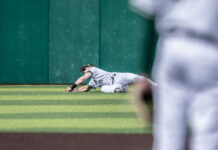Even in a small town nearly 50 miles from any major city, an extremely rural area where less than 1% of the population identifies as black or African-American alone, growth in racial diversity is possible. But it likely wouldn’t be possible without Slippery Rock University — its athletics, specifically.
But, according to Paul Lueken, Slippery Rock director of athletics, the university is not where it needs to be just yet.
“We’re not there yet,” Lueken said. “Just based on sheer numbers, we’re not. If you just look at the percentage numbers of student body enrollment, and you look at the minority enrollment compared to predominantly white enrollment, we’re not where we need to be yet.”
While the Slippery Rock borough boasts a population of 3,590, according to datausa.io, 93.1% of the population, approximately 3,340 people, identifies as white. In comparison, 0.95% of the population, approximately 34 people, identify solely as black.
Diversity across the student population at Slippery Rock University is slightly better, with 7,526 students identifying as white (85.46%) and 378 identifying as black (4.29%) in the 2019 fall semester.
No matter how it’s spun, Slippery Rock, the borough and the university, is a mainly white area, and that’s where athletics comes into play.
In the 2019 spring semester, Slippery Rock recorded an enrollment of 8,806 students. Down from 8,824 in the 2018 fall semester; and the enrollment of black, non-Hispanic students dropped from 385 in 2018 to 378 in 2019.
Over the past six years, dating back to the 2014 fall semester, the total student population has fluctuated within a few thousand students, but the black, non-Hispanic student population has seen a decrease since 2016.
With just a bit more than 4% of the student population identifying as black at Slippery Rock University, even in a down season in athletic diversity, 12.13% of student-athletes identify as black, and that number jumps to 19.32% of athletes that identify as two or more races are included.
“Our percentage of student-athletes that classify as a minority, African-American or multi-race, is 21 to 22%, roughly, every year,” Lueken said. “Which is three or four times more than the regular student body, so that helps with diversity on campus.”
In Division II athletics, the level of representation of black athletes across the major sports of football and men’s and women’s basketball has slowly begun to increase.
With 1,751 white student-athletes (40%) and 2,688 black student-athletes (52%) playing men’s basketball in 2008, both total numbers have increased over the last 10 years. However, the percentage of white student-athletes has decreased to just 33% while black student-athletes represent 51% of the total number.
Football has experienced a more drastic shift in representation, with 7,786 white student-athletes (52%) and 6,183 black student-athletes (42%) in 2008. Over the next 10 years, the number of black student-athletes increased over 2,000 and now represents 46% while white student-athletes remained relatively stable in total numbers but decreased to 41% representation.
Women’s basketball has experienced a slight in the total number of black student-athletes, rising from 1,314 student-athletes to 1,599. However, the percent of representation has held steady at 34%. The number of white student-athletes has risen by 80, jumping from 2,312 to 2,323 in the past 10 years.
At the Pennsylvania State Athletic Conference level, only football has experienced substantial diversification over the past 10 years.
The number of white student-athletes and black student-athletes has increased in the past 10 years, jumping from 67 and 142 to 71 and 166, respectively. Both percentages have dipped as white student-athletes represented 31% and black student-athletes represented 66% while those numbers sit at 27% and 62% 10 years later.
Football has experienced a rapid change as the number of black student-athletes surpassed the number of white student-athletes over the past 10 years. There are 694 black student-athletes (48%) and 643 white student-athletes (44%) compared to 342 black student-athletes (31%) and 717 white student-athletes (65%) in 2018.
Women’s basketball went basically unchanged in the PSAC over the past 10 years as white student-athletes jumped from 136 to 162, dropping from 64% to 62% representation, while black student-athletes rose from 68 to 82, holding steady at 32% representation.
Not just the PSAC institutions, but across the Pennsylvania State System of Higher Education institutions, Lueken pointed to the desire for diversification at all levels of the state system, not just athletics.
“There’s not a school right now in the state system that doesn’t want to diversify,” Lueken said. “That’s a goal, it’s one of the strategic goals of the state system. So, that means there’s scholarship money available, and it’s not just our state system. It’s all across the country.”
While the major sports have experienced increased levels of diversity at Slippery Rock University, especially in regard to black student-athletes, the traditionally “white” sports have made little headway in terms of racial diversity.
“We’ve increased our numbers, especially African-American student-athletes,” Lueken said. “Especially in certain sports, we’ve grown. In some of our sports, there’s not a lot of underrepresented student-athletes playing those sports.”
In the 2018-2019 academic year, 445 student-athletes were enrolled at the university and on athletic rosters.
Men’s basketball and football were the most diverse athletic teams at Slippery Rock, accounting for 43 of the 54 black student-athletes at the university.
In terms of percentages, football was composed of just over 40% of white student-athletes and just over 35% of black student-athletes.
Lueken highlighted the progress that football has undergone in the past 10 years in diversifying its roster. Especially for the area in which Slippery Rock is located, Lueken said.
Men’s basketball, the most diverse team on Slippery Rock’s campus, was made up of white student-athletes (12.5%) and eight black student-athletes (50%).
Almost identical to the PSAC average, the women’s basketball team was comprised of 10 white student-athletes and six black student-athletes. The percentages of 62.5 and 37.5 nearly mirror the conference average of 62% and 32%, respectively.
While football was not quite as the Division II or PSAC levels, the team has made strides over the past 10 years and boasts over half of the black student-athletes at the university.
In regard to the “white” sports in the PSAC, varsity sports at Slippery Rock, slight increases in diversity have been achieved. But in women’s field hockey and women’s lacrosse, while the percentage of white student-athletes has dropped from 95% in 2008, the percentage still hovered around 90% in 2018.
In the 2018-2019 season, women’s lacrosse and women’s field hockey at SRU had no black student-athletes. Tennis, volleyball, and baseball also recorded no black student-athletes while softball was 100% comprised of white student-athletes.
However, while women’s lacrosse, field hockey, tennis and volleyball and men’s baseball appear to be rather homogenous, each closely mirrors the conference standard.
Other than football and men’s and women’s basketball, only men’s soccer and men’s and women’s track included black student-athletes.
Men’s soccer closely mirrored the conference average, comprised of 64.29% of white student-athletes and 14.29% of black student-athletes.
Men’s and women’s track, while more diverse than a majority of teams at the university, fell short of the conference average. Men’s track was 86.54% white and women’s track was 85% white. Both had a black student-athlete representation of around 6%.
Even with the struggles in fielding a diverse roster in sports that already suffer from a lack of underrepresented student-athletes, Lueken said Slippery Rock athletics serve as a pivotal cog in promoting diversity in the university and community alike.
“We play a pretty important role [in promoting diversity], and we want to keep doing that. We focus on inclusion. We have minority staff and minority coaches, too. I’ve always said in regard to the student-athlete body, 450 to 475 student-athletes, we’re probably, as a group, the most diverse group on campus in terms of inclusion and diversity.”
With Slippery Rock smackdab in the middle of an area with very, very little black representation, the opportunity for black student-athletes to call SRU home increases the awareness of members of the community.
“It brings more exposure to people that live in our community, which as you know, is a predominantly white community,” Lueken said. “It’s a positive thing, and the nice thing about it is that our student-athletes are good role models. Good citizens of the community that they’re in.”
Lueken pointed to individuals like former Rock quarterback Roland Rivers III and star basketball player Micah Till providing local children with stellar role models who make the most of their increased role within the community, based on their standings in athletics.
Lueken said that the entire athletic department takes it upon themselves to work in the community, that it wasn’t just limited to a few student-athletes here and there.
“Our student-athletes all go out into the community, almost all the teams do, and work in community service and interacting with folks in the community,” Lueken said.
While Lueken admitted that Slippery Rock is far from perfect, he was proud of the progess SRU has made.
“If anything, we can be a shining example of how you can [start to increase diversity], but it takes work,” Lueken said. “And it takes time and some money.”








